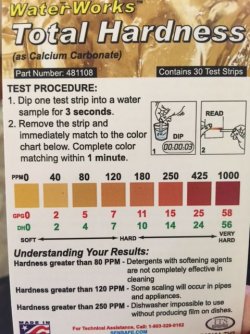Ok, my Water Hardness Test Strips came in the mail and I tested the tank. According to the strip, the PPM is 250, with a GPG of 15 and a DH of 14 (image is attached). I assume this is bad, because the ph is 8.0. What can I do to soften my water? I have yet to lose a fish, but I can't imagine this is a good environment for them and I want to remedy this asap.
Any insight is much appreciated.
thanks,
Casey
First, concerning the present fish mentioned earlier i this thread, I wouldn't worry too much. Your water is harder than they would prefer, but the danios and glofish and dwarf gourami are commercially raised and this is not the issue it would be with some other species like characins (tetras) or wild caught soft water fish.
For the future, should you decide to remove these fish (give them away, or they die), fish well suited to your water are livebearers (any of them, subject to tank size). Rift lake cichlids too, but here you get into other issues I won't go into, and I'm not suggesting you have space for most of these, but to be fair I must mention them.
Now, to your question of softening the water. This can be done, but it is somewhat involved. Initially, it is fairly straightforward: you dilute the tap water with some form of "pure" water. Distilled water, RO (reverse osmosis) water, and if it is otherwise safe, rainwater can all be used. Personally I would use rainwater if you are not near industrial sources of pollution, and collect it safely (in clean tubs, not runoff from a roof). Diluting hard water is roughly proportional; mixing half tap and half pure would reduce the GH by half, etc. Rainwater has the added advantage of being slightly acidic. But with the GH and KH reduced, the pH would lower proportionally, depending upon the mixing volumes. This is without doubt the safest way to soften the water.
Other methods are filtering the water through peat, using organics like wood and dried leaves, etc. But while these processes will soften the water and acidify it, they will not do this at any appreciable level such as you need here. The initial GH and KH is very high, and that is going to work to maintain things as they are unless the water is diluted.
The problem with this is future water changes, that will need similarly prepared water. With only one tank this is perhaps not too onerous (I have 8 tanks, hundreds of gallons of water, and this would be a nightmare for me). Emergency water changes can be difficult though, and one should always plan for these. At the first sign of trouble with fish, a major water change is usually the best first step.
RO units are not inexpensive, and they do waste a lot of water in the process. But some aquarists use them.
Byron.


